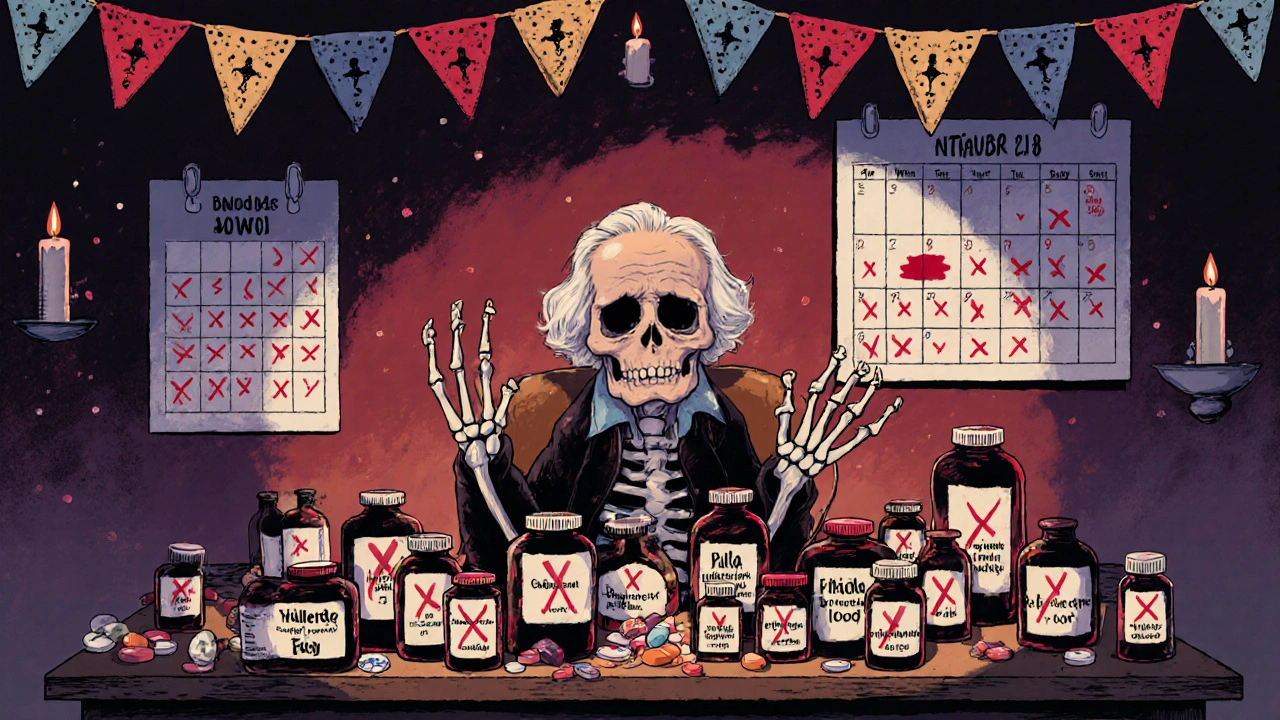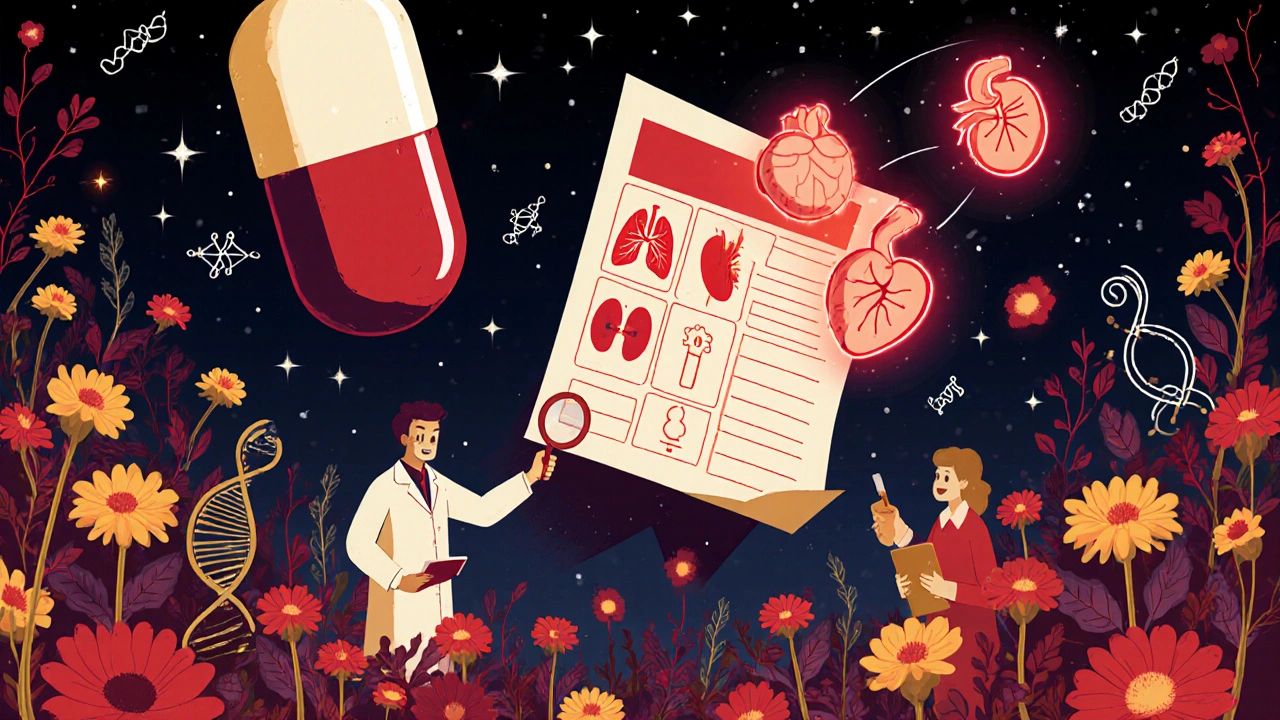Cumulative Dose Risk Calculator
Calculate Your Medication Risk
Track how your medication builds up over time and identify when you might approach dangerous levels.
Your Cumulative Dose Results
Cumulative Dose: 0 mg
Time to Threshold: N/A days
Based on your daily dose
Important Recommendations
- Check liver function every 3 months
- Get blood level tests at least monthly
- Report new symptoms immediately: fatigue, dizziness, muscle pain
Most people think side effects show up right away - maybe a headache after taking a new pill, or nausea after your first chemo cycle. But what if the real danger isn’t in the first dose, but the 50th? That’s where cumulative drug toxicity comes in. It’s not a sudden reaction. It’s a slow creep. Over weeks, months, or even years, your body slowly fills up with a drug it can’t fully flush out. And when it hits a tipping point, things go wrong - often badly.
Why Some Drugs Build Up in Your Body
Not all drugs are created equal when it comes to how your body handles them. Some are cleared quickly - within hours. Others? They stick around. Drugs with long half-lives - meaning they take more than 24 hours to reduce by half in your bloodstream - are the biggest culprits. Think amiodarone for heart rhythm, lithium for bipolar disorder, or digoxin for heart failure. These can hang on for days or even weeks. Fat-soluble drugs are another problem. Vitamins A, D, E, and K don’t dissolve in water, so your body stores them in fat tissue. Heavy metals like lead or mercury? They bury themselves in bones. Once stored, they come out slowly. A single dose might seem harmless. But take it daily for six months? That’s when levels start climbing past safe limits. Your liver and kidneys do the heavy lifting to remove these substances. But if they’re not working at full speed - because of age, diabetes, chronic kidney disease, or even just years of wear and tear - clearance drops by 30% to 50%. That means even normal doses can become dangerous over time.The Silent Progression: How Toxicity Sneaks Up
Unlike an allergic reaction or overdose, cumulative toxicity doesn’t scream for attention. It whispers. You might feel a little tired. Your hands might shake a bit more than usual. Your appetite dips. These signs are easy to brush off as stress, aging, or just "getting older." But they’re signals your body is drowning in a drug it can’t get rid of. A study from the Journal of the National Cancer Institute tracked cancer patients on targeted therapies. In the first treatment cycle, about 25% had noticeable side effects. By the sixth cycle, that number dropped to just 2%. Sounds good, right? Not quite. The real story was hidden: the total number of patients who developed serious side effects by cycle six jumped to over 50%. The side effects weren’t getting less - they were just showing up later, and more people were affected. This pattern repeats across medications. Anticoagulants like warfarin can cause internal bleeding after years of use. Statins might quietly damage muscles. Even common antibiotics like tetracycline can lead to permanent tooth discoloration in children if taken repeatedly over time.Who’s Most at Risk?
Older adults are the most vulnerable. Why? Their organs slow down. Their bodies hold onto more fluid. Their metabolism changes. The American Geriatrics Society’s Beers Criteria lists 34 medications that carry high cumulative toxicity risk for seniors - everything from certain sleep aids to painkillers to heart medications. People with chronic conditions are also at higher risk. If you have kidney disease, your body can’t flush out drugs like lithium or aminoglycoside antibiotics effectively. Liver disease? That messes up how your body breaks down drugs like amiodarone or acetaminophen. And then there’s the issue of polypharmacy - taking five, six, or more medications at once. Each drug competes for the same enzymes in your liver. One might block another from being cleared, causing both to build up. It’s like a traffic jam in your bloodstream.
Real Cases: When Monitoring Fails
One oncologist on Reddit shared a case that’s chillingly common. A patient was on amiodarone for years. Blood tests showed normal levels every time. No red flags. Then, after the cumulative dose passed 600 grams, the patient developed severe lung scarring - pulmonary fibrosis. By then, it was too late. The damage was permanent. The FDA’s adverse event database shows over 12,000 reports of cumulative toxicity between 2018 and 2022. Nearly half involved blood thinners. Almost a third involved heart drugs. These aren’t rare cases. They’re the tip of the iceberg. A Medscape survey of 1,200 doctors found that 67% had seen at least one serious case of cumulative toxicity in the past year. And 82% blamed it on patients missing follow-up blood tests or not telling their doctors about new symptoms.How Doctors Are Trying to Stop It
The good news? There are tools to catch this before it’s too late. Therapeutic drug monitoring (TDM) is the gold standard for high-risk meds. It means regularly checking blood levels - not just to see if the drug is working, but to make sure it’s not building up. For digoxin, lithium, and aminoglycosides, this is standard practice. But it’s not universal. Many doctors still rely on symptoms alone, which is like driving with your eyes closed. In oncology, cumulative dose limits are written into guidelines. For example, anthracycline chemotherapy drugs like doxorubicin have a hard cap: 450 mg per square meter of body surface area. Exceed that, and your risk of irreversible heart damage spikes. That number isn’t random. It comes from 17 clinical trials with over 8,500 patients. Some hospitals now use automated tracking systems. One rheumatology clinic started tracking cumulative methotrexate doses in their electronic records. Within a year, serious side effects dropped by 37%. That’s not luck. That’s systems working.
What You Can Do
You don’t have to wait for your doctor to catch it. Be proactive.- Ask: "Is this medication known to build up in the body?" If yes, ask when and how often you should get blood tests.
- Keep a log. Write down every pill you take - name, dose, frequency. Include supplements and over-the-counter drugs. Bring it to every appointment.
- Don’t ignore "minor" symptoms. Fatigue, tingling, dizziness, changes in urine color, unexplained bruising - these aren’t just "normal aging." Ask if they could be drug-related.
- If you’re on long-term meds, ask your pharmacist to review your entire list. Pharmacists are trained to spot dangerous interactions and accumulations.
- Know your limits. For example, if you’re on statins, ask if you’re due for a CK (creatine kinase) blood test to check for muscle damage.
The Bigger Picture: Why This Matters
The global market for therapeutic drug monitoring is growing fast - projected to hit nearly $5 billion by 2028. Why? Because hospitals and insurers are realizing how expensive cumulative toxicity is. It leads to hospitalizations, emergency visits, lost work, and permanent disability. In cancer care alone, cumulative toxicity causes 22% of dose reductions and 15% of treatment stops. That costs the U.S. healthcare system over $1.2 billion a year. New tech is coming. AI models at places like Memorial Sloan Kettering are analyzing 27 different factors - age, kidney function, genetics, other meds - to predict your personal risk of toxicity before it happens. These tools aren’t mainstream yet. But they’re coming. The European Medicines Agency now requires cumulative toxicity assessments for every new drug meant for long-term use. That’s a big step. The U.S. isn’t there yet - but it’s moving.Final Thought: It’s Not About Avoiding Meds. It’s About Managing Them.
No one should stop taking life-saving medication because they’re scared of side effects. But you should never take them blindly, either. Cumulative toxicity isn’t a flaw in the drug - it’s a flaw in how we assume all drugs behave the same way. The truth is, your body changes. Your liver slows. Your kidneys weaken. Your medication list grows. What was safe last year might not be safe this year. Ask questions. Track your meds. Know your numbers. Your future self will thank you.Can cumulative drug toxicity be reversed?
It depends on the drug and how much damage has been done. For some, like liver enzyme changes from statins, stopping the drug and giving your body time can lead to full recovery. For others, like lung scarring from amiodarone or heart damage from anthracyclines, the damage is permanent. Early detection is key - once tissue is scarred or cells are dead, your body can’t repair it. That’s why monitoring matters.
Are over-the-counter drugs capable of cumulative toxicity?
Yes. Acetaminophen (Tylenol) is a prime example. Taking 4,000 mg a day - the maximum daily dose - for months can quietly damage your liver. Many people think it’s "safe" because it’s available without a prescription. But it’s processed by the liver, and long-term use adds up. Herbal supplements like kava and comfrey can also build up and cause liver injury over time.
How often should I get blood tests if I’m on long-term medication?
There’s no one-size-fits-all answer. For lithium or digoxin, monthly checks are common at first, then every 3-6 months if stable. For drugs like methotrexate, blood counts and liver enzymes are checked every 4-8 weeks. Ask your doctor what’s right for your specific drug and health status. If you’re over 65 or have kidney/liver issues, you may need more frequent testing.
Can genetic testing help predict cumulative toxicity risk?
Yes, in some cases. Genetic tests can show if you’re a slow metabolizer for certain drugs - meaning your body breaks them down much slower than average. For example, people with a CYP2D6 or CYP2C19 gene variant may be at higher risk for toxicity from antidepressants, blood thinners, or beta-blockers. These tests aren’t routine yet, but they’re becoming more common in oncology and psychiatry.
Why don’t all doctors check for cumulative toxicity?
Time, cost, and lack of awareness. Many primary care doctors see dozens of patients a day. Tracking cumulative doses for every long-term medication isn’t built into most electronic records. Plus, some drugs don’t have clear safety thresholds, or testing isn’t widely available. But this is changing. As costs of hospitalizations rise and new monitoring tools become cheaper, more clinics are adopting these practices - especially in specialties like cardiology and oncology.


Tiffanie Doyle
October 28, 2025 AT 15:12james landon
October 29, 2025 AT 11:29Jenn Clark
October 29, 2025 AT 15:28L Walker
October 31, 2025 AT 04:58giri pranata
October 31, 2025 AT 09:58Stuart Rolland
November 1, 2025 AT 04:17Kent Anhari
November 1, 2025 AT 14:39Charlos Thompson
November 2, 2025 AT 03:36